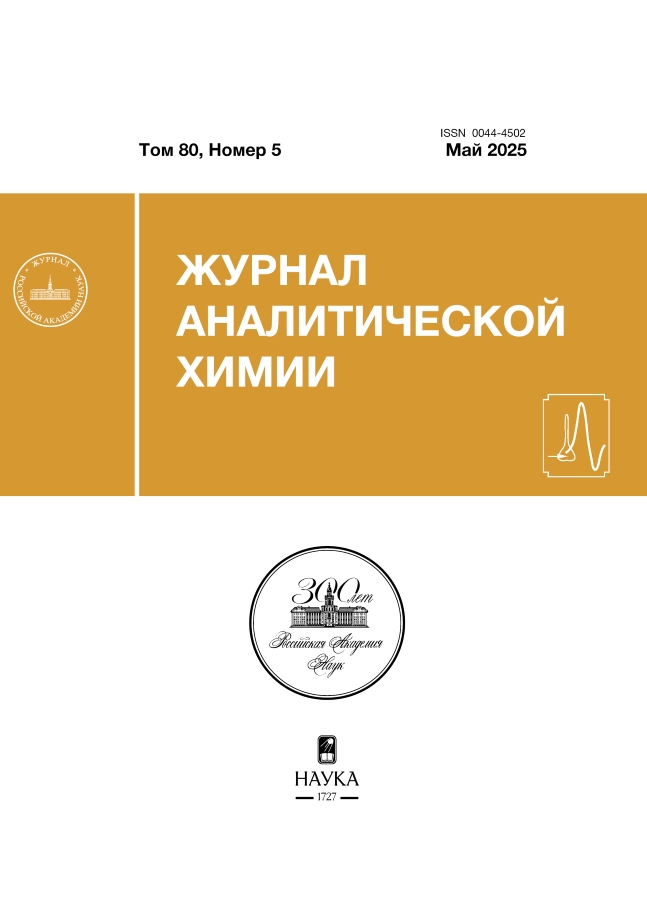Inverse multivariate graduations as a means of separate determination of similar analytes from the spectrum of a non-additive light absorption mixture
- Autores: Vlasova I.V.1, Matusevich A.A.1, Vershinin V.I.1
-
Afiliações:
- F.M. Dostoevsky Omsk State University. F.M. Dostoevsky
- Edição: Volume 80, Nº 5 (2025)
- Páginas: 518-525
- Seção: ORIGINAL ARTICLES
- ##submission.dateSubmitted##: 20.06.2025
- ##submission.dateAccepted##: 20.06.2025
- URL: https://rjmseer.com/0044-4502/article/view/685447
- DOI: https://doi.org/10.31857/S0044450225050073
- EDN: https://elibrary.ru/atrfwd
- ID: 685447
Citar
Texto integral
Resumo
Multivariate graduations are used in spectrophotometric analysis for the determination of a number of analytes in multicomponent solutions. These graduations relate generalized signals measured at multiple wavelengths to analyte concentrations. The purpose of this work is to test the applicability of inverse multivariate graduations (OMG) for the separate determination of analytes of the same type when their light absorption is non-additive. The objects of analysis were model aqueous solutions simultaneously containing Cu(II), Co(II), Ni(II), Zn(II), Pb(II) and an excess of the photometric reagent 4-(2-pyridylazo) resorcinol. In such solutions, statistically significant deviations from light absorption additivity were observed, probably caused by a shift in the complexation equilibrium. The initial data for the construction of OMGs were spectra of model mixtures from the training sample. The number of analytical wavelengths (m) and the number of mixtures in the training sample (n) were varied during the experiment. Metal concentrations in the mixtures from the test sample were calculated separately by multiple linear regression using different spectral intervals and different OMGs. The best results were obtained at m = 16 and n = 30. The errors of determination of Co, Ni and Zn in single mixtures do not exceed 25 oz.% (modulo), and the generalized errors (RMSEP) were 10-15 oz.%. The errors of copper and lead determination were characterized by much higher values. The experiment showed that OMG can be used to separately determine components of mixtures with similar but not additive spectra. However, the volume of initial data in this case should be much larger than in the assessment of the total content of the same analytes, the accuracy of the results will be lower, and the possibility of correct determination of all analytes is not guaranteed.
Texto integral
Sobre autores
I. Vlasova
F.M. Dostoevsky Omsk State University. F.M. Dostoevsky
Autor responsável pela correspondência
Email: vlaso-iri@yandex.ru
Rússia, Omsk
A. Matusevich
F.M. Dostoevsky Omsk State University. F.M. Dostoevsky
Email: vlaso-iri@yandex.ru
Rússia, Omsk
V. Vershinin
F.M. Dostoevsky Omsk State University. F.M. Dostoevsky
Email: vlaso-iri@yandex.ru
Rússia, Omsk
Bibliografia
- Rambla F.J., Garrigues S., de la Guardia M. PLS-NIR determination of total sugar, glucose, fructose and sucrose in aqueous solutions of fruit juices // Anal. Chim. Acta. 1997. V. 344. P. 41.
- Ni Y., Huang C., Kokot S. Application of multivariate calibration and artificial neural networks to simultaneous kinetic-spectrophotometric determination of carbamate pesticides // Chemometr. Intel. Lab. Systems. 2004. V. 28. № 5. P. 177.
- Vershinin V.I., Petrov S.V. The estimation of total petroleum hydrocarbons in waste waters by multiwave IR spectrometry with multivariate calibrations // Talanta. 2016. V. 148. P. 163.
- Bozdogan A., Acar A.M., Kunt G.K. Simultaneous determination of acetaminophen and caffeine in tablet preparations by partial least-squares multivariate spectrophotometric calibration // Talanta 1992. V. 39. № 8. P. 977.
- Перьков И.Г., Дрозд А.В., Арцебашев Г.И. Выбор оптимальных длин волн и прогнозирование погрешностей в многокомпонентном спектрофотометрическом анализе // Журн. аналит. химии. 1987. Т. 42. № 1. С. 68.
- Brereton R.G. Introduction to multivariate calibration in analytical chemistry // Analyst. 2000. V. 125. № 11. P. 2125.
- Esbensen K.H. Multivariate Data Analysis – in Practice. An Introduction to Multivariate Data Analysis and Experimental Design. 5th Ed. Woodbridge: Camo Process. AS, 2004. 588 p.
- Olivieri A.C., Faber N.M., Ferre J., Boque R. Uncertainty estimation and figures of merit for multivariate calibration (IUPAC Technical Report) // Pure Appl. Chem. 2006. V. 78. № 4. P. 633.
- Антонова Т.В., Вершинин В.И., Власова И.В. УФ-спектрометрическое определение суммарного содержания аренов в сточных водах // Журн. аналит. химии. 2021. Т. 76. № 7. С. 603.
- Вершинин В.И., Баженова Л.С. Применение обращенных многомерных градуировок для определения суммарного содержания фенолов / Заводск. лаборатория. Диагностика материалов. 2023. Т. 89. № 9. С. 5.
- Власова И.В., Вершинин В.И. Спектрометрическое определение суммарного содержания однотипных аналитов с помощью обращенных многомерных градуировок // Журн. аналит. химии. 2022. Т. 77. № 11. С. 1032. https://doi.org/10.31857/S0044450222110159
- Отто М. Современные методы аналитической химии (в 2-х т.т.). Т. 2. М.: Техносфера, 2004. С. 138.
- Берштейн И.Я., Каминский Ю.А. Спектрофотометрический анализ в органической химии. Л.: Химия, 1986. 200 с.
- Иванов В.М. Гетероциклические азотсодержащие азосоединения. М.: Наука, 1982. 229 с.
- Новый справочник химика и технолога. Аналитическая химия. Часть 3. / Под ред. Калинкина И.П. СПб: НПО “Профессионал”, 2004. 692 с. (табл. 14.4.16).
- Булатов М.И. Расчеты равновесий в аналитической химии. Л.: Химия, 1984. 184 с.
- Бурюкина П.А., Власова И.В., Спиридонова К.А. Применение хемометрических алгоритмов в спектрофотометрическом анализе смесей с подобными спектрами поглощения // Аналитика и контроль. 2013. Т. 17. № 3. С. 333.
Arquivos suplementares













